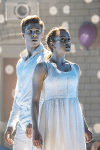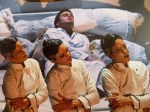 Has there ever been an original work that has inspired more variations than Romeo and Juliet? From the Russian ballet of Tchaikovsky and Prokofiev, to West Side Story and a whole lot of other works, those star-cross’d lovers have influenced so many creative souls. And in language too – how many times have you heard that someone was “a bit of a Romeo”? I’m yet to meet “a bit of a Juliet”, although, considering Matthew Bourne’s new version, that might not altogether be a bad thing….
Has there ever been an original work that has inspired more variations than Romeo and Juliet? From the Russian ballet of Tchaikovsky and Prokofiev, to West Side Story and a whole lot of other works, those star-cross’d lovers have influenced so many creative souls. And in language too – how many times have you heard that someone was “a bit of a Romeo”? I’m yet to meet “a bit of a Juliet”, although, considering Matthew Bourne’s new version, that might not altogether be a bad thing….
 Following their successful Lord of the Flies, Matthew Bourne’s New Adventures company has continued its groundbreaking work with young dancers. Not only have some of that class of 2014 gone on to carve dance careers for themselves, but for more than a year now the company has worked with six young, local dancers in each of the locations where Romeo + Juliet will be staged, integrating them seamlessly into the professional cast. It wasn’t until the final curtain call that I worked out who were the local young dancers in our production – each and everyone of them gave a first-class performance and I have great hopes for what they will go on to achieve.
Following their successful Lord of the Flies, Matthew Bourne’s New Adventures company has continued its groundbreaking work with young dancers. Not only have some of that class of 2014 gone on to carve dance careers for themselves, but for more than a year now the company has worked with six young, local dancers in each of the locations where Romeo + Juliet will be staged, integrating them seamlessly into the professional cast. It wasn’t until the final curtain call that I worked out who were the local young dancers in our production – each and everyone of them gave a first-class performance and I have great hopes for what they will go on to achieve.
Set in the not too distant future, the Verona Institute is one of those vaguely intimidating establishments that may have originally been set up for the good of its patients (or its inmates, or its captives, you decide) but has gone distinctly off-message with the cruelty of its security staff and the strictness of its mentors. Think Nurse Ratched from One Flew Over the Cuckoo’s Nest in cahoots with Hamidou the prison guard in Midnight’s Express and you get the picture. Only the kindly Rev. Bernadette Laurence, who happily encourages music, dancing and – let’s not deny it – sexual intimacy between members of her imprisoned flock, goes against the grain – albeit to no benefit to herself.
 Some adaptations are close to the original; others are not. This, being Matthew Bourne’s conception, takes the original Romeo and Juliet as a mere hint of a serving suggestion. There’s no sense of warring Montagues and Capulets, no prior love intrigue between Romeo and Rosaline, no apothecary and no poison. Tybalt, rather than channelling his violence towards massacring Montagues, concentrates on physical and sexual abuse towards Juliet, traditionally his cousin. Mercutio and Balthasar have a gay relationship; and Juliet kills Romeo, which, having thought long and hard about it in the hours since I saw the show, is a concept with which I still have a lot of problems.
Some adaptations are close to the original; others are not. This, being Matthew Bourne’s conception, takes the original Romeo and Juliet as a mere hint of a serving suggestion. There’s no sense of warring Montagues and Capulets, no prior love intrigue between Romeo and Rosaline, no apothecary and no poison. Tybalt, rather than channelling his violence towards massacring Montagues, concentrates on physical and sexual abuse towards Juliet, traditionally his cousin. Mercutio and Balthasar have a gay relationship; and Juliet kills Romeo, which, having thought long and hard about it in the hours since I saw the show, is a concept with which I still have a lot of problems.
 All the hallmarks of a top-quality Matthew Bourne production are there. Lez Brotherston’s set is so evocative of a municipal/school swimming pool with its white shiny bricks, and its separate Boys and Girls entrances (to which no one pays any attention), that you can almost smell the chlorine. What makes it different is the prison-style barred doorways and gates that step up the sense of the young patients being shut off and incarcerated. Outside there’s probably an exercise yard. Why anyone would voluntarily check in, like Romeo’s parents appear to do with him, beats me. Remind me not to book into the Verona Institute; it isn’t anything like as appealing as it looks in the promotional brochure.
All the hallmarks of a top-quality Matthew Bourne production are there. Lez Brotherston’s set is so evocative of a municipal/school swimming pool with its white shiny bricks, and its separate Boys and Girls entrances (to which no one pays any attention), that you can almost smell the chlorine. What makes it different is the prison-style barred doorways and gates that step up the sense of the young patients being shut off and incarcerated. Outside there’s probably an exercise yard. Why anyone would voluntarily check in, like Romeo’s parents appear to do with him, beats me. Remind me not to book into the Verona Institute; it isn’t anything like as appealing as it looks in the promotional brochure.
Brett Morris’ fantastic orchestra play those sumptuous Prokofiev melodies with power and eloquence. The score has been re-orchestrated for this production, choosing a different combination of instruments, in an attempt to modernise it, create an acoustic sound-world (so says the programme) and make it generally more relevant. It works very well; the music is stunning throughout and accompanies the dancing perfectly.
 The dancers are all on excellent form, with some beautiful pas de deux from Paris Fitzpatrick and Cordelia Braithwaite as the eponymous couple, the powerfully menacing movement and presence of Dan Wright as the fearsome Tybalt, and a characterful and cheeky coupling of Reece Causton as Mercutio and Jackson Fisch as Balthasar. Daisy May Kemp brings humour to the role of the Reverend Bernadette, and there’s some superb and eye-catching work from Callum Bowman’s Sebastian, Hannah Mason’s Frenchie and Bryony Harrison’s Dorcas.
The dancers are all on excellent form, with some beautiful pas de deux from Paris Fitzpatrick and Cordelia Braithwaite as the eponymous couple, the powerfully menacing movement and presence of Dan Wright as the fearsome Tybalt, and a characterful and cheeky coupling of Reece Causton as Mercutio and Jackson Fisch as Balthasar. Daisy May Kemp brings humour to the role of the Reverend Bernadette, and there’s some superb and eye-catching work from Callum Bowman’s Sebastian, Hannah Mason’s Frenchie and Bryony Harrison’s Dorcas.
However, despite all these excellent ingredients, apart from Balthasar’s decline into zombie level distress after the death of Mercutio, I found it all strangely unmoving. The dance begins, Blood Brothers-like, with a melodramatic tableau of the dead Romeo and Juliet on their slab, so you already know it’s imbued with fatalism and isn’t going to end well. The dancing and choreography are spectacular to watch, the visual effects are very powerful (wardrobe must curse all that blood on those nice white clothes), and there are some amusing and horrific vignette moments that keep you thoroughly entertained. But at the end of the day, I feel this is too far away from the original Romeo and Juliet story to bathe in its reflected tragedy. Of course, as a Matthew Bourne creation, it naturally still towers over many other modern dance productions, simply by dint of its expansiveness, its inventive choreography and its overall vision.
 The tour continues to Plymouth, the Lowry, Cardiff, Sadler’s Wells, Norwich, Birmingham, Canterbury, Southampton, Nottingham and winds up in Newcastle in mid-October. Bourne aficionados will want to see it as a matter of course, and will doubtless love its sheer spectacle; why wouldn’t you? Romeo and Juliet fans might be slightly more disappointed. It goes without saying that the terrific performances carry it through; but, knowing how astounding Sir Matthew’s dance works can be, something in me kinda wanted more.
The tour continues to Plymouth, the Lowry, Cardiff, Sadler’s Wells, Norwich, Birmingham, Canterbury, Southampton, Nottingham and winds up in Newcastle in mid-October. Bourne aficionados will want to see it as a matter of course, and will doubtless love its sheer spectacle; why wouldn’t you? Romeo and Juliet fans might be slightly more disappointed. It goes without saying that the terrific performances carry it through; but, knowing how astounding Sir Matthew’s dance works can be, something in me kinda wanted more.
Production photos by Johan Persson



















































